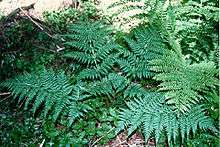Dryopteris expansa
Dryopteris expansa, the alpine buckler fern, northern buckler-fern[1] or spreading wood fern, is a species of fern native to cool temperate and subarctic regions of the Northern Hemisphere, south at high altitudes in mountains to Spain and Greece in southern Europe, to Japan in eastern Asia, and to central California in North America. The species was first described from Germany. It prefers cool, moist mixed or evergreen forests and rock crevices on alpine slopes, often growing on rotting logs and tree stumps and rocky slopes. It is characteristically riparian in nature, and is especially associated with stream banks.
| Dryopteris expansa | |
|---|---|
 | |
| Scientific classification | |
| Kingdom: | Plantae |
| Clade: | Tracheophytes |
| Class: | Polypodiopsida |
| Order: | Polypodiales |
| Suborder: | Polypodiineae |
| Family: | Dryopteridaceae |
| Genus: | Dryopteris |
| Species: | D. expansa |
| Binomial name | |
| Dryopteris expansa (C. Presl) Fraser-Jenk. & Jermy | |
Description
It has a stout, woody, creeping or ascending stock with large, green lacy fronds typically 10–60 cm (4–24 in) and rarely 90 cm (35 in) long. The deltate[2] fronds are bipinnate at the base, pinnate toward the apex. The rhizome is erect or ascending, often producing offshoots. Sori occur medially on the underside of the pinnae. Propagation is by spores and vegetatively by division of the rhizome.
It is easily confused with the related Dryopteris dilatata (broad buckler fern), differing in the usually smaller fronds, and in the pale brown scales on the frond stem being more uniform in color, rarely having a dark central stripe. It also differs in cytology in having 2n = 82 chromosomes (164 in D. dilatata). Leaves of D. expansa are very similar to those of D. arguta.[3]
The species name of this fern, expansa, is from the Latin expando, meaning "to spread out, spread apart, to expand". Other common names include northern wood fern, arching wood fern, spiny wood fern and crested wood fern.
Uses
The root contains filicin, a substance that paralyses tapeworms and other internal parasites and has been used in herbal medicine as a worm expellent.
References
- "BSBI List 2007". Botanical Society of Britain and Ireland. Archived from the original (xls) on 2015-01-25. Retrieved 2014-10-17.
- Jenkins Fraser and Jermy Fraser. 1977. Dryopteris expansa (C. Presl), Brit. Fern Gaz. volume 11: page 338.
- C. Michael Hogan. 2008. Coastal Woodfern (Dryopteris arguta), GlobalTwitcher, ed. N. Stromberg Archived 2011-07-11 at the Wayback Machine
External links
| Wikimedia Commons has media related to Dryopteris expansa. |
- Flora Europaea. Dryopteris expansa
- Flora of North America Dryopteris expansa
- Plants For A Future: Dryopteris expansa
- Rünk, Kai; Zobel, Martin; Zobel, Kristjan (2012). "Biological Flora of the British Isles: Dryopteris carthusiana, D. dilatata and D. expansa". Journal of Ecology. 100: 1039–1063. doi:10.1111/j.1365-2745.2012.01985.x.
